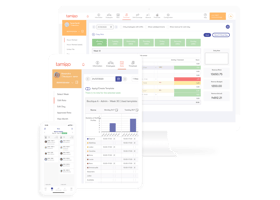If you’ve ever worked on the shop floor, you’ll know the pressures of being understaffed. Long queues at the checkout, rising stress levels.
But understaffing’s effects go way beyond the emotional impact on employees and customers. Company profits feel the impact too.
In this article, we'll take a look at the problems understaffing causes, and then some understaffing solutions.
Why is being understaffed bad for business?
Here’s 3 detrimental effects of being understaffed.
1. Productivity and profits suffer
Understaffing loses your business money in the long term.
Now, that may strike you as counterintuitive. Payroll accounts for a big portion of retailers' operating budgets, so isn't reducing it going to save you money?
Quite the opposite. Study after study has shown retail stores are leaving money on table due to inadequate staffing levels. Up to 14% of potential sales in each location. Across national and international chains that quickly adds up.
Why hasn't this hit home for some retailers? Well, it’s easier to understand short term gains — in this case, savings on weekly payroll — than longer term, more complex losses. Especially for store managers and planners who aren’t so focused on the longer-term picture.
We’ll give Rogelio Oliva the final word on this. His study on understaffing in U.S. retailers found that even a slight increase in employee numbers triggered an uptick in sales.
Regardless of the type of retailer, the takeaway is that stores need to move past the inclination to minimize cost by understaffing because it can have a big impact on profitability. Stores should staff to maximize sales and profit, not to minimize costs.
Rogelio Oliva, Professor, Mays Business School
2. Morale takes a nosedive
We all have the occasional bad day at work. But lean staffing levels can make them the norm.
In a 2019 survey from REPL Group, U.S. retail workers called out understaffing as their “biggest frustration”. That's above salaries or holiday time. In the UK, 47% of retail workers felt understaffed over the festive period.
How does this translate to their work?
Employees are more likely to:
- Make mistakes in their work
- Give customers a bad quality of service, or be too rushed to serve them
- Become stressed and burnt-out, resulting in more absenteeism
In that same 2019 survey, 80% of respondents said that their job satisfaction would improve with better managed staffing levels.
3. Your brand loses its luster
Long waiting times and poor customer service damage trust in a retailer’s brand.
Bad word of mouth in real life is one thing, but online review sites like Trustpilot, Facebook and Yelp also hold huge sway over consumer habits. A whopping 67% of consumers won’t make a purchase from a company with 1–3 bad online reviews.
Speaking of the web, what’s one advantage physical stores have over online ones? Great face-to-face customer service! It’s a foundational value for most retailers. Take that away and you’re giving people one more reason to stay home.
Tips for dealing with understaffing
So what's the solution? Here's two approaches to take.
Look ahead with data
Time machines are hard to come by. This makes planning future shifts a tricky balancing act. Overestimate customer demand and you’re left with staff standing around doing nothing. Go too far the other way — suddenly you’re struggling to cope.
Decision-making built on hard data eliminates guesswork. With a workforce management (WFM) solution, store managers and planners have a wealth of numbers and KPIs at their fingertips.
- Historic labour costs and sales
- Expected wage percentages
- Footfall data
- Workload forecasts
- Employee check-in and -out times
This can be imported manually or through seamless integrations with the rest of your IT architecture. Through tamigo's open API you can sync everything from your POS to your workload forecasting software.
This data is also available to other stakeholders across the business: from HR to District managers to the CFO. Everyone's working off the same numbers, making collaboration and weekly meetings that much more fruitful.
It’s planning ahead, minus the guesswork!
Further reading: KPIs for retail: Which ones should you measure?
Simplify your communication
Schedules in retail businesses tend to fluctuate. A lot. Your workforce is split between full- and part-timers, students and seasonal workers. And there’s always plenty of shifts being swapped.
On top of that, you’ve got to keep everyone informed of their hours in this ever-evolving schedule. Otherwise, you may be faced with a short-staffed shop floor.
Workforce management software take away the confusion.
The latest schedule is always viewable in the app for both managers and employees. Plus, they can easily message each other with employee communication tools.
Lakrids by Bülow, one of Denmark’s most recognisable confectionary brands, began using tamigo in 2012. It replaced their old system of scheduling staff via emails (which often went unanswered).
When you only have young people employed, it is a huge plus that communication about the schedule and shift exchange takes place via text message on tamigo's user-friendly app.
Anita Møllebro, Retail Design Manager, Lakrids by Bülow
Improved communication and data are the hallmarks of a WFM solution. And tamigo has so much more to offer too! To learn more about tamigo for the retail industry, check out our dedicated retail page.





